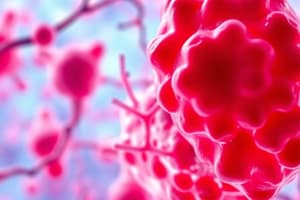Podcast
Questions and Answers
What are acquired gene mutations primarily responsible for?
What are acquired gene mutations primarily responsible for?
- Inherent genetic disorders
- Infectious diseases
- All forms of genetic diseases
- The majority of cancer cases (correct)
What is the nature of sporadic cancer?
What is the nature of sporadic cancer?
- It affects individuals only in their childhood
- It occurs due to environmental factors exclusively
- It is caused by acquired mutations in a person's lifetime (correct)
- It is inherited from parents
Which of the following tumors is classified as a type of skin cancer?
Which of the following tumors is classified as a type of skin cancer?
- Adamantinoma of the jaw
- Astrocytoma of the brain
- Basal cell carcinoma of the skin (correct)
- Craniopharyngioma of the pituitary gland
Which statement accurately describes acquired gene mutations?
Which statement accurately describes acquired gene mutations?
Which tumor type is specifically associated with the appendix?
Which tumor type is specifically associated with the appendix?
How do acquired mutations differ from other genetic mutations?
How do acquired mutations differ from other genetic mutations?
Which type of cancer is primarily associated with acquired gene mutations?
Which type of cancer is primarily associated with acquired gene mutations?
What type of tumor is an adamantinoma?
What type of tumor is an adamantinoma?
Which of the following tumors primarily affects the brain?
Which of the following tumors primarily affects the brain?
Which tumor is located in the pituitary gland region?
Which tumor is located in the pituitary gland region?
What characteristic allows tumor cells to give rise to all cell types found in the tumor?
What characteristic allows tumor cells to give rise to all cell types found in the tumor?
What does self-renewal in tumor cells imply about their proliferative capabilities?
What does self-renewal in tumor cells imply about their proliferative capabilities?
Which statement best describes a minor population within tumor cells?
Which statement best describes a minor population within tumor cells?
What is the primary characteristic of tumors of unknown behavior?
What is the primary characteristic of tumors of unknown behavior?
Why are some tumor cells able to resist treatment with drugs and radiation?
Why are some tumor cells able to resist treatment with drugs and radiation?
Which type of tumors arise from epithelial cells?
Which type of tumors arise from epithelial cells?
What does cell stress resistance indicate about tumor cells?
What does cell stress resistance indicate about tumor cells?
Which characteristic does NOT apply to tumors of unknown behavior?
Which characteristic does NOT apply to tumors of unknown behavior?
What is a common source for the classification of tumors based on their tissue of origin?
What is a common source for the classification of tumors based on their tissue of origin?
Which statement best describes epithelial tumors?
Which statement best describes epithelial tumors?
What characteristic distinguishes cancer cells from normal cells?
What characteristic distinguishes cancer cells from normal cells?
Which statement about the specialization of cancer cells is accurate?
Which statement about the specialization of cancer cells is accurate?
What is a common trait of cancer cells in relation to growth signals?
What is a common trait of cancer cells in relation to growth signals?
How do cancer cells typically respond to apoptosis compared to normal cells?
How do cancer cells typically respond to apoptosis compared to normal cells?
In what way do cancer cells differ from normal cells regarding their life cycle?
In what way do cancer cells differ from normal cells regarding their life cycle?
What does the term 'In Situ' refer to in the context of tumors?
What does the term 'In Situ' refer to in the context of tumors?
What characterizes a malignant tumor?
What characterizes a malignant tumor?
Which of the following statements is true regarding malignant tumors?
Which of the following statements is true regarding malignant tumors?
How do 'In Situ' tumors differ from malignant tumors?
How do 'In Situ' tumors differ from malignant tumors?
What is the main risk associated with malignant tumors?
What is the main risk associated with malignant tumors?
Flashcards
Acquired Gene Mutations
Acquired Gene Mutations
Changes in genes that happen during a person's lifetime.
Sporadic Cancer
Sporadic Cancer
Cancer caused by acquired gene mutations.
Tumors of Unknown Behavior
Tumors of Unknown Behavior
Tumors whose behavior cannot be determined based on the information available.
Epithelial Tumors
Epithelial Tumors
Signup and view all the flashcards
Cancer cells are less specialized
Cancer cells are less specialized
Signup and view all the flashcards
Cancer cells ignore apoptotic signals
Cancer cells ignore apoptotic signals
Signup and view all the flashcards
In Situ Tumor
In Situ Tumor
Signup and view all the flashcards
Malignant Tumor
Malignant Tumor
Signup and view all the flashcards
Metastasis
Metastasis
Signup and view all the flashcards
Primary Tumor
Primary Tumor
Signup and view all the flashcards
Secondary Tumor
Secondary Tumor
Signup and view all the flashcards
Tumorigenic
Tumorigenic
Signup and view all the flashcards
Unlimited Proliferative Capacity
Unlimited Proliferative Capacity
Signup and view all the flashcards
Cancer Stem Cells
Cancer Stem Cells
Signup and view all the flashcards
Cancer Cell Resistance
Cancer Cell Resistance
Signup and view all the flashcards
Immune Evasion
Immune Evasion
Signup and view all the flashcards
Basal cell carcinoma
Basal cell carcinoma
Signup and view all the flashcards
Adamantinoma
Adamantinoma
Signup and view all the flashcards
Carcinoid tumor
Carcinoid tumor
Signup and view all the flashcards
Astrocytoma
Astrocytoma
Signup and view all the flashcards
Craniopharyngioma
Craniopharyngioma
Signup and view all the flashcards
Study Notes
Neoplasia (Tumors)
- A tumor is a new growth of tissue, often forming a mass. A malignant neoplasm is cancer.
- Neoplasia means "new growth" (neo-plasia).
Cancer
- Cancer is uncontrolled cell division of genetically abnormal cells that spread locally and to distant sites.
- Cancer development involves an interaction between environmental factors and a susceptible host.
- Normal cells divide as needed, attach to other cells, stay in place, and commit suicide (apoptosis) when no longer needed. Cancer cells do not stop dividing, detach, and can invade other tissues.
Cancer Cell vs. Normal Cell Differences
- Cancer cells lack specialization compared to normal cells.
- Cancer cells ignore programmed cell death (apoptosis) signals.
- Cancer cells impact the surrounding tissue (microenvironment) and may evade the immune system.
Cancer Causes (DNA Damage)
- Environmental factors (e.g., tobacco, radiation, UV rays, viruses).
- Endogenous causes (e.g., reactive oxygen species (ROS), metabolic processes).
- Random DNA Replication Errors
- Protective measures (DNA repair enzymes, apoptosis) are often bypassed in cancerous cells.
Gene Mutations
- Gene mutations permanently alter DNA, leading to abnormal proteins or preventing proper protein formation.
- Acquired mutations are most common, occurring during a person's lifetime. Sporadic cancers result.
- Germline mutations are less common, inheritable (from parent to child), and related to inherited cancers, which account for 5% - 20% of cancers.
Genes Linked to Cancer
- Tumor Suppressor Genes: Protect by monitoring cell division, repairing DNA, and regulating apoptosis. Recessive mutations diminish their function, leading to cancer.
- Oncogenes: Genes that promote cell growth. Dominant mutations increase their function, leading to uncontrolled growth & cancer.
Classification of Tumors
- Behavior: Benign (slow growth, no spread), In Situ (localized), Malignant (uncontrolled, spreads), Unknown.
- Tissue of Origin: Epithelial (cells lining organs, glands), Connective tissue (bone, cartilage, fat).
Microscopic Criteria of Malignant Cells
- Undifferentiated cells (anaplastic): Lacking normal tissue characteristics.
- Atypical/pleomorphic: Varying in size and shape.
- Hyperchromasia: Darker, increased DNA content in the nucleus.
- Increased N/C ratio: Larger nucleus compared to cytoplasm.
- Prominent nucleoli: Larger nucleoli in the nucleus.
- Loss of polarity: Disorganized arrangement.
- Abnormal Mitosis: Irregular cell divisions.
Methods of Spread of Malignant Tumors
- Local invasion: Tumors spread directly into surrounding tissues.
- Blood spread: Tumors enter blood vessels to spread to other parts of the body, forming emboli.
- Lymphatic spread: Tumors travel via lymphatic vessels to regional lymph nodes.
Transcoelomic Implantation
- Spread of tumors through body cavities like the peritoneum.
Cancer Stem Cells (CSCs)
- Stem cells within tumors.
- Drive tumor formation and recurrence.
- Less common but highly tumorigenic.
Important Tumor Characteristics
- Angiogenesis (blood vessel formation) is crucial for tumor growth.
- Tumors secrete factors to promote angiogenesis, bypass the normal regulation, and form new blood vessels to feed the tumor, leading to tumor growth and metastasis.
Papilloma
- Benign epithelial tumors, associated with HPV. Grossly appear as cauliflower-like growths.
Adenoma
- Benign tumor originating from glandular tissue. Present as a rounded or polypoid growth.
Carcinoma
- Malignant epithelial tumor. Grossly appears as a fungating/polypoid mass, or infiltrating or ulcerative.
Teratoma
- Tumor of embryonic germ cells. Consists of tissues from multiple germ layers.
Hamartoma
- Focal malformation with abnormal tissue mixture.
Para-neoplastic Syndromes
- Disorders caused by tumor-produced substances (e.g., hormones, cytokines). Examples include Cushing syndrome and hypercalcemia.
Growth Disturbances
- Hyperplasia: Increased cell number.
- Hypertrophy: Increased cell size.
- Atrophy: Decreased organ size/cell size.
- Metaplasia: Change in one tissue type to another.
- Dysplasia: Abnormal cellular development.
Studying That Suits You
Use AI to generate personalized quizzes and flashcards to suit your learning preferences.



